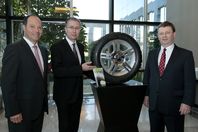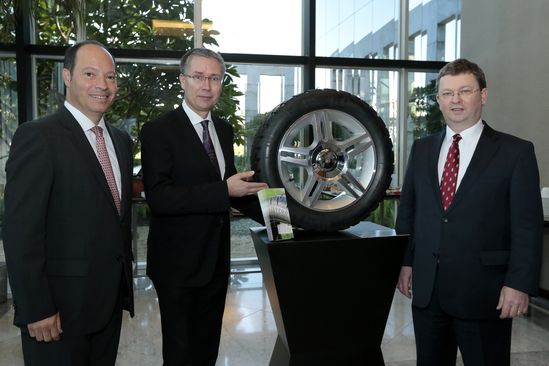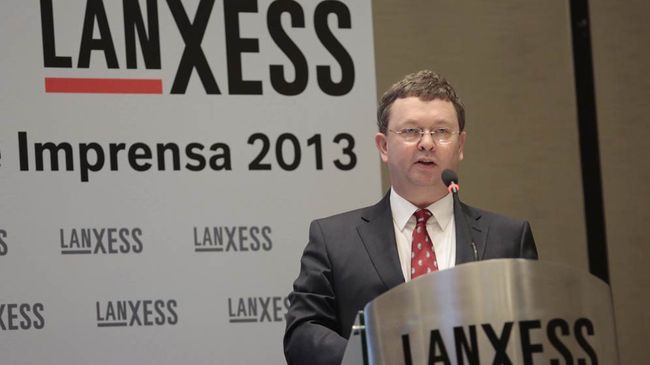Asia
EMEA

LANXESS Canada Contacts
Contact our Sites in Canada
Media Inquiries
General Inquiries
Please click here to e-mail LANXESS Canada with product inquiries and general requests.
Global Press Releases
2013-03-04
LANXESS strengthens standing as world’s leading high-performance rubber producer
- Production switch to S-SBR from E-SBR in Triunfo, Brazil
- EUR 80 million investment
- Growing demand for “Green Tires” due to megatrend mobility and tire labelling
- Brazilian tire labelling expected in H2, 2016
- S-SBR in combination with Nd-PBR achieves best performance in “Green Tires”
LANXESS is strengthening its standing as the world’s leading producer of high-performance rubber. Following a feasibility study, the German specialty chemicals company has decided to convert production of emulsion styrene butadiene rubber (E-SBR) used in standard tires to solution styrene butadiene rubber (S-SBR) used in high-performance “Green Tires” at its site in Triunfo (Rio Grande do Sul) in southern Brazil. LANXESS is the first company to carry out such a conversion.
The future capacity for S-SBR in Triunfo will be 110,000 metric tons per year, exactly the same as the current E-SBR capacity. The switch in production technology represents an investment of EUR 80 million, which will be financed from the company’s cash-flow. Up to 500 temporary workers will be needed during the conversion phase. The plant will produce the latest grades of S-SBR at the end of 2014. A regular supply of E-SBR to customers will be maintained from the company’s plant in Duque de Caxias (Rio de Janeiro) in Brazil, which has enough production capacity to supply the entire Brazilian E-SBR demand. E-SBR is mainly used in the manufacturing and retreading of truck tires, which means tire carcasses can be reused several times, thus saving raw materials for tire production.
LANXESS is the world’s largest producer of high-performance rubbers, including S-SBR and neodymium-based performance butadiene rubber (Nd-PBR) sold under the Buna brand name. Global growth for both rubber types is estimated at roughly 10 percent per year, up to 2017, as consumers shift to more fuel-efficient and environmentally-friendly “Green Tires”.
“We are delighted to announce another major synthetic rubber investment in Brazil, which underscores our commitment to our sites and employees here,” said LANXESS Board Member, Werner Breuers, at a press conference in São Paulo today. “We want to provide our customers with the best technology they deserve in order to fulfill their expansion plans in this important market.”
New capacities to meet strong demand for “Green Tires”
Demand for “Green Tires” is being driven by the megatrend mobility, above all in the regions of Asia and Latin America, as the middle class there becomes more affluent. In addition, demand will accelerate as tire labeling continues to be introduced around the world.
November 2012 saw the launch of mandatory tire labeling in the European Union (EU), similar to the consumer labels found on refrigerators and washing machines. Tires are graded from A (best) to G according to their fuel efficiency and from A to F according to their wet grip. Rolling noise is also measured. Therefore, the new legislation provides greater transparency for consumers by highlighting the added value of “Green Tires”.
Japan and South Korea were the first countries in the world to introduce a labeling system. After a voluntary tire label was introduced in Japan in January 2010, South Korea launched its voluntary labeling program in November 2011 and introduced a mandatory label in December 2012. The Brazilian government aims to implement tire labeling, modeled on the EU standards, as of October 2016, while the topic in China is taking shape as part of the country’s current five-year-plan.
Studies show that 20-30 percent of a vehicle’s fuel consumption and 24 percent of road vehicle’s CO2 emissions are related to tires. “Green Tires” can reduce fuel consumption by 5-7 percent and have a shorter cost amortization period in comparison to other fuel-saving technologies in cars such as automatic start-stop systems and hybrid drives.
“This means consumers can save real money in times of rocketing gasoline prices,” said Breuers.
Synthetic rubber drives “Green Tires”
“Green Tires” can reach their peak performance with formulations containing both S-SBR and Nd-PBR. S-SBR is mainly used in the tread compound of “Green Tires” and Nd-PBR is used in the treads and sidewalls. While both rubbers help to increase fuel efficiency of a tire by reducing rolling resistance, S-SBR helps improves grip on wet roads, while Nd-PBR is highly resistant to abrasion thus making tires more durable.
“We are now moving from the age of tire design to the age of tire materials, which will make the difference in performance,” said Joachim Grub, Head of the LANXESS’ Performance Butadiene Rubbers (PBR) business unit. “And here LANXESS is playing a leading role in developing high-performance materials for the tires of tomorrow.”
Last year, LANXESS showcased an “AA-rated” concept tire that was developed by the company in Germany and tested by TÜV SÜD, one of the world's leading independent technical service organizations. The concept tire comprises the latest generation Nd-PBR and S-SBR technology, as well as rubber additives, to achieve a grade of “A” for both rolling resistance and wet grip under the new EU tire-labeling rules. It is one of the first tires in the world to achieve an AA-rating.
Global asset base for high-performance rubber
In the past two years, LANXESS has increased its global capacities for the high-performance rubbers S-SBR and Nd-PBR by 70,000 metric tons per annum. The company has achieved this through debottlenecking measures at its plants in Dormagen, Germany, Orange, USA and Cabo de Santo Agostinho (Pernambuco), Brazil. In addition, the company produces S-SBR at is facility in Port Jérôme, France.
In addition, the company broke ground for a new world-scale Nd-PBR plant in Singapore last September to serve, above all, the growing Asian tire industry. The plant, representing a total investment of EUR 200 million, will have a capacity of 140,000 metric tons per year and will start up in the first half of 2015.
S-SBR and Nd-PBR belong to LANXESS’ Performance Butadiene Rubbers (PBR) business unit. Alongside tires, performance butadiene rubbers are used for the modification of plastics in the manufacture of High-Impact Polystyrene (HIPS) for injection molding applications. Other applications include golf balls, running shoes and conveyor belts. PBR is part of LANXESS’ Performance Polymers segment, which achieved total sales of EUR 4 billion in the first nine months of 2012.
Successful growth story in Brazil
Brazil is one of the most successful and fastest-growing markets for LANXESS products and a cornerstone of the company’s BRICS strategy. The country accounted for less than one percent of LANXESS’ global sales in 2005 but now accounts for roughly 10 percent of global sales. Marcelo Lacerda is Country Representative for the company’s national activities. LANXESS became one of the largest chemical companies in Brazil following its acquisition of Petroflex in 2008 and now employs roughly 1,100 workers at its headquarters and seven locations.
LANXESS is a leading specialty chemicals company with sales of EUR 8.8 billion in 2011 and currently around 17,100 employees in 31 countries. The company is currently represented at 48 production sites worldwide. The core business of LANXESS is the development, manufacturing and marketing of plastics, rubber, intermediates and specialty chemicals. LANXESS is a member of the leading sustainable indices Dow Jones Sustainability Index (DJSI) World and FTSE4Good as well as the Carbon Disclosure Leadership Index (CDLI).
- Gallery








